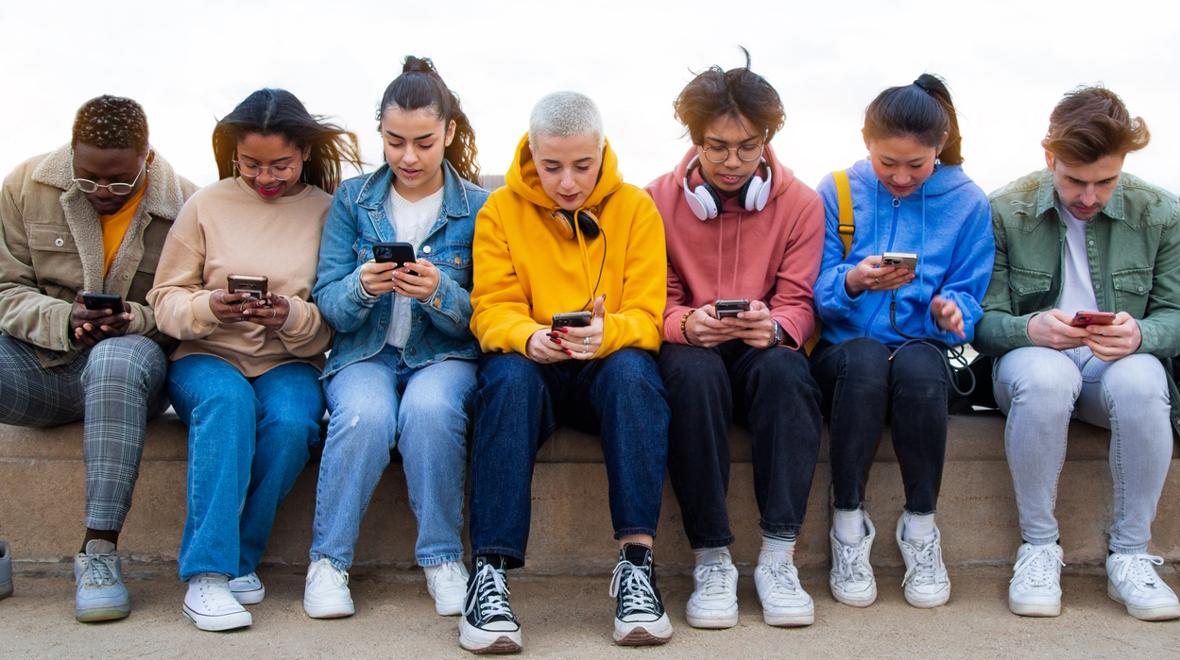
Photo:
Social media use is nearly universal among teenagers. One-third of U.S. youth ages 13–17 report that they use a social media platform “almost constantly,” according to 2023 data from the Pew Research Center. Photo: iStock
Recently, physician and filmmaker Delaney Ruston posed an intriguing question on the blog for her film “Screenagers: Growing Up in the Digital Age”: Could kids be paid to leave social media? As a mom to a teenager with a YouTube channel and a few SnapChat streaks, I couldn’t help but wonder if Dr. Ruston might be onto something.
I asked my own “extremely online” child what he thought about this question and he said he’d happily walk away from social media for free. That’s when I knew I not only needed to get some second opinions, but I also needed a reporter who was not born before the internet or mothering the respondents to be asking the questions.
I reached out to our friends at TeenTix to connect with one of the journalists from their youth press corp. Seattle Public Schools 11th grader Juliana Agudelo Ariza was up for the assignment. So, how much money would it take to get teens to give up social media for a month? Juliana’s findings might surprise you.
– Kristin Leong, senior editor
|
For more support and resources surrounding the youth mental health crisis, screen time and social media, and the importance of play, visit ParentMap’s Antidote for the Anxious Generation page. |
The cost of getting teens to unplug
As a rising junior in high school, I know firsthand how social media can provide so many benefits just as much as it can lead to endless spirals.
What if there were ways to incentivize people to think about the role that social media plays in their lives? What kind of changes could be possible?
Inspired by Dr. Ruston’s article and curious about answering these questions for myself, I invited young people from around the world to voice their opinions about their own social media usage.
Teens around the world respond
Through a 15-question survey, respondents answered the overarching question: How much money would it take to get you to leave social media for a month?
Thirty-one respondents participated in the survey, spanning from ninth to 12th grade. Respondents were located across the globe, in cities like Seattle, London, Giza, Taipei, Colombo and more. Over eight countries were represented in total. This survey focused on teen’s use of the following social media platforms: Instagram, Facebook Messenger, Snapchat, Twitter, YouTube, Discord and Reddit.
For high school students, social media use is not just for entertainment, but an essential way for students to keep up with the latest happenings like events and friend gatherings. I found that around 35 percent of those surveyed utilized social media to stay connected with their friends, family and school. Respondents highlighted the crucial role that these platforms have in reaching farther-away friends and relatives while expanding their ability to access a larger network of people.

For working teens, social media is priceless
Social media proved to be crucial for the daily lives of many high schoolers, including myself. For the aforementioned reasons, the ranges tended to correlate based on their need. Below are some of the results of this survey:
- Six people (19.4 percent) answered that they would completely leave social media for a month for free.
- Five people (16 percent) said that they would leave for $10–$100.
- Seven people (22.6 percent) chose $101–$400.
- Nine people (29 percent) chose $500–$900.
- One person (3 percent) chose $901–$1,500.
- One person (3 percent) stated that they would require over $1,500 to leave social media for a month.
Lastly, two high school students (6.5 percent) responded that they would never be able to get off of social media, no matter the financial incentive.
Teens who listed a value greater than $900 generally had to use social media as part of their job, as some of them work as social media managers or content creators. It seems that someone who uses social media to watch videos will not value it as much as someone who creates those videos.

Seasonal shifts in social media needs
I interviewed a few of the respondents to learn more about their choices. Hazel Smith, a 10th grader from Seattle Public Schools, noted the difference between using social media during the school year versus during the summer. For her, the monetary offer to leave social media is subject to change depending on her schedule.
“It depends heavily on the time of year because during the summer, I am no longer in school. I don’t need to use it to communicate with people and I don’t need it for entertainment,” she says. “But if it’s in the middle of winter, I need information about my sports, about my classes, about school events and about friends who go to different schools. I think it would be upward of $200 because I need social media to get information from my school and friends.”
Social media dependence is a result of how intertwined these platforms have become in our daily lives, especially for young people. Around 68 percent of the students surveyed indicated that the way society and networking work now makes social media necessary to their lives.
Inside jokes, fashion and fun keep kids plugged in
The number one reason some wanted higher compensation was FOMO, or fear of missing out.
I can speak from experience: These days, everybody wants to be in the loop and know what’s happening around them. Whether it be catching up with friends, posting pictures or glancing at the news, social media keeps us updated about the latest happenings, so it’s natural that no one wants to feel left out.
For young people today, even the small things like inside jokes and fashion trends (for me, it’s the what to wear inspiration) are important to keep tabs on.
Another reason social media is so important in our lives? It’s simply fun. Entertainment was one of the biggest reasons why teens were reluctant to renounce social media for a month.
The top platforms among our respondents were Instagram, YouTube and Pinterest. Teens shared that they use those platforms to watch videos, learn new things, get inspiration, relax and keep up with trends.
The dark side to constant connection
On the flip side to the fun, many also shared that social media is a distraction that can have negative consequences.

The survey asked what teens disliked and what they hoped the future would be like within the scope of social media. Most felt that social media had a grip on their lives that led to endless hours of doom scrolling.
Ivy Liu, another 10th grader, provided her perspective into what makes social media addicting. “Media company people, they make your ‘For You’ page or [default page settings] exactly like your interest. So, you get stuck in this loop of just watching videos and it’s hard to get out of it,” she said.
Like Liu, others mentioned that they feel trapped by social media and acknowledged that its design is supposed to make it hard to get rid of.
Others noted the negative effects of comparing yourself to people you see online, how misinformation spreads quickly and how people can generally be rude and harass others, all of which can have dangerous mental health consequences.
Hope for the future despite conflicting wants and no easy answers
There was a paradoxical sense that while some wanted more freedom in terms of the topics they could research, others wanted more limits to prevent inappropriate behavior and negativity. Many respondents expressed that they wanted social media to have more nuance and fine-tune its content based on its audience.
While we may never reach agreement on how social media should be managed, or how much money should be paid to get us off social media, since it’s here to stay, we hope it continues to improve in the future.
More help navigating the digital landscape: |
This article was written through a ParentMap collaboration with TeenTix Press Corps, a youth journalism program where teens process, interpret and think critically about the art and media they engage with. TeenTix is a youth empowerment and arts access nonprofit based in Seattle. This story was edited by ParentMap senior editor Kristin Leong in collaboration with TeenTix teen programs director Mariko Smithashima.











